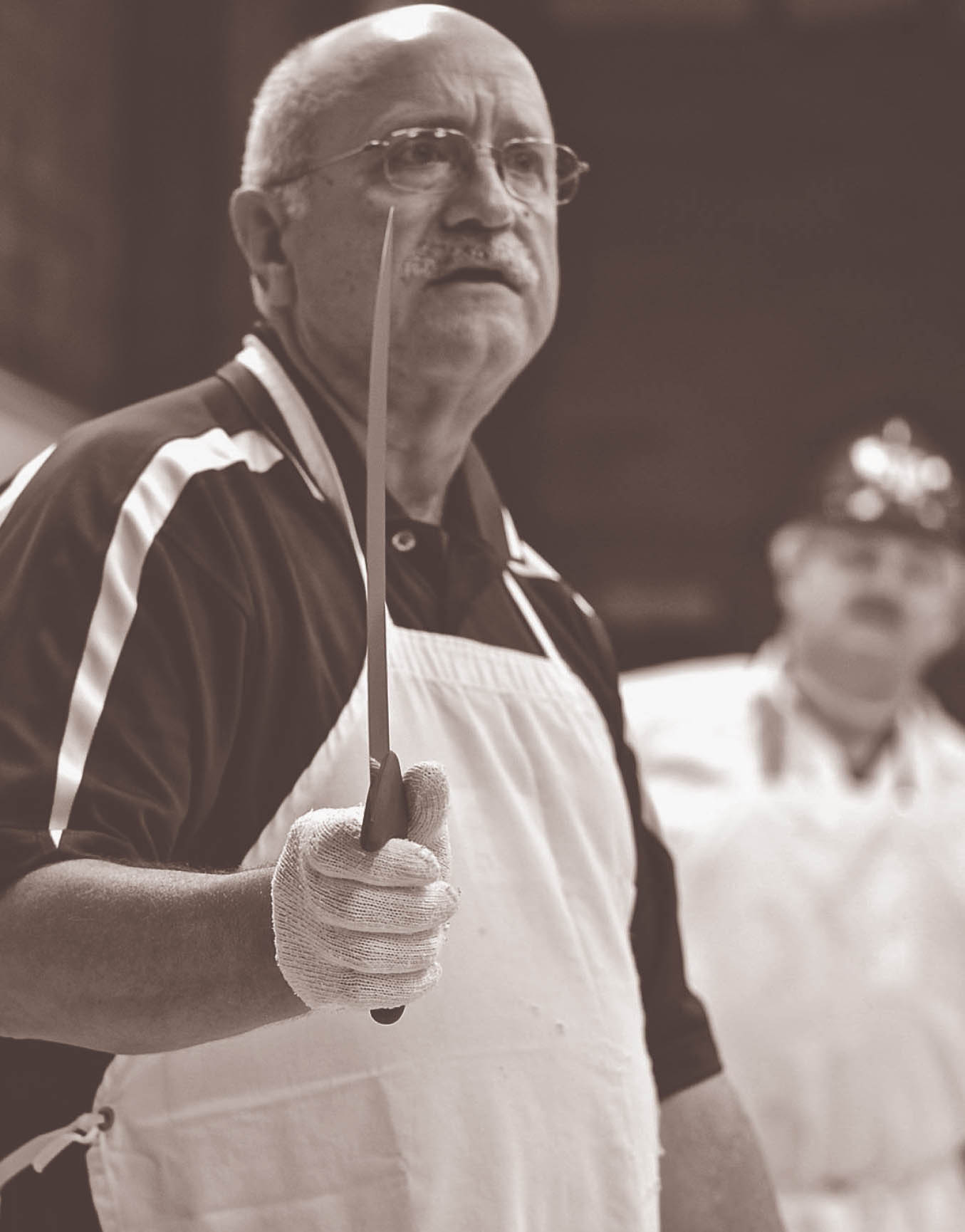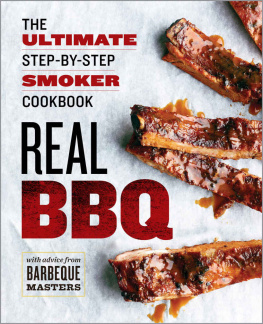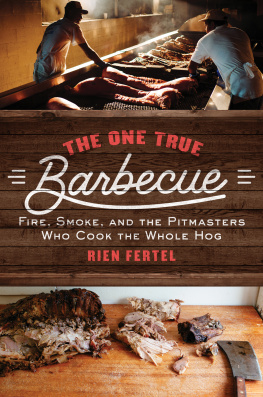

Captain Will Wright of the Texas Rangers cooks his dinner over a campfire (circa 1930).
Photo: Texas State Library Archives Division

A barbecue stand made of corrugated tin, Corpus Christi, 1939.
Photo by Russell Lee

 In memory of Phil Born
In memory of Phil Born
Copyright 2002 and 2016 by Robb Walsh.
All rights reserved. No part of this book may be reproduced in any form without written permission from the publisher. constitutes a continuation of the copyright page.
ISBN 978-1-4521-4625-6 (epub, mobi)
Library of Congress Cataloging-in-Publication Data available.
ISBN 978-1-4521-3998-2 (pb)
Designed by Erin Mayes and DJ Stout, Pentagram, Austin
Typesetting by River Jukes-Hudson
Diagrams by A.J. Garces, with revisions on by Amanda Fung
Chronicle Books LLC
680 Second Street
San Francisco, California 94107
www.chroniclebooks.com

Mopping the meat at the Annual Millheim Fathers Day Barbecue

A far-flung family dynastyeach of the four Mikeska brothers built a barbecue restaurant in a different Texas town. Left to right: Jerry, Maurice, Rudy (deceased), and Clem.
Photo by Will van Overbeek

Dr. Savell at Barbecue Summer Camp.
Foreword
My first encounter with Legends of Texas Barbecue Cookbook by Robb Walsh occurred one summer day about ten years ago in a Harry & Davids store in San Marcos, Texas. While my wife was shopping, I happened on a display featuring the book. I picked one up and began to browse through it. Impressed by the blend of history and recipes, I somewhat absentmindedly carried it with me to the checkout counter and added it to my wifes pile of merchandise. Now, looking back on that day, its amazing what a profound impact that impulse purchase had on how I have spent the last six years of my life.
I read the book when we got home and then put it on our cookbook shelf, ready to pick up again when a good barbecue recipe was needed. But Legends of Texas Barbecue would end up playing a far greater role in my life than that.
In the spring of 2009, Texas A&M University asked the faculty to teach first-year seminars for incoming freshmen. These one-hour courses for small groups would feature subjects the students might find interesting, but the real goal was to give ten to fifteen freshmen contact with professors who could help them make the transition from high school to college.
The pilot program in 2008 included a class on baseball taught by a history professor. As a meat science professor, I immediately thought, if you can teach a course on baseball, why not a course on Texas barbecue? And I knew that I already had the perfect textbook for the class: Robb Walshs Legends of Texas Barbecue Cookbook.
Texas Barbecue, now known as ANSC 117 in the Texas A&M course catalog, was first taught in the fall of 2009. During the semester, I got an e-mail from none other than Robb Walsh seeking assistance with a story he was working on about fajitas. I told him I recognized his name because I was using his book for the barbecue class. Instead of answering his questions about the meat cuts used for fajitas, I invited him to come and visit the Meat Science Center for a hands-on demonstration of the various cuts.
When Robb showed up on campus, I asked him to come back and talk to the class. And he has come back every year since that first visit. The twenty-five lucky freshmen who take the course get to hear one of the most knowledgeable guest lecturers on barbecue around, and they also get Robb Walsh to personally autograph their textbooks.
If the story ended there, it would be great, but there is more. In May 2010, I invited Robb to the Texas A&M Beef Center to participate in Beef 101, our three-day course on learning everything about beef, from the live animal to the final products. I also invited him to be a guest speaker at the universitys Rosenthal Lecture Series, to bring our students up-to-date on popular topics affecting the meat industry, such as nose-to-tail cookery.
Whenever we talked, Robb told me about his dream of creating an organization to preserve our food culture in Texas, much as the University of Mississippibased Southern Foodways Alliance does for the South. I told Robb that Texas A&M would be glad to help, but that the Department of Animal Science did not do cultural and historical documentationthat we are, after all, agricultural subject-matter experts.
Despite my protestations, in July 2010, Robb talked me into providing the lecture hall at the Beef Center as a venue for the all-day meeting of fifty key leaders in the Texas food scene. That gathering gave birth to Foodways Texas, whose mission is to preserve, promote, and celebrate the diverse food cultures of Texas. The organization is now headquartered at the University of Texas at Austin. Somehow, I ended up sitting on its first board of directors.
To be successful, Foodways Texas needed to conduct educational programs that appealed to the public. The Texas barbecue scene was undergoing a renaissance at the time, fueled by coverage from television shows and the rapid response that social media created whenever someone discovered a great new barbecue joint.
Robb and I brainstormed a barbecue seminar and a hands-on workshop that combined food culture and food science, with catering provided by star pitmasters. The logical place to hold it was the Texas A&M Meat Science Center, where we would have meat cutting labs and sides of beef and whole hogs at our disposalnot to mention a bunch of meat science professors and graduate students who were passionate about barbecue.
The first Barbecue Summer Camp, a joint venture between Foodways Texas and Texas A&M University, was held in June 2011. We thought it would appeal to backyard barbecue enthusiasts, but we were humbled by the number of cook-off winners, master chefs, and other experts who showed up.
Enthusiastic press coverage, blog write-ups, and just plain word of mouth resulted in sellouts every time the seminar has been held. To satisfy the demand for barbecue instruction, we started Camp Brisket in January 2013, which, as the name implies, focuses on this most difficult of all cuts. Tickets for Camp Brisket 2015 sold out in two minutes.
Thanks to the give and take between instructors and some of the most knowledgeable students of barbecue imaginable, Barbecue Summer Camp and Camp Brisket are keeping on top of changes in Texas barbecue and providing help in understanding new techniques, new equipment, and newly popular cuts of meat. In this second edition of Legends of Texas Barbecue Cookbook
Next page











 In memory of Phil Born
In memory of Phil Born

